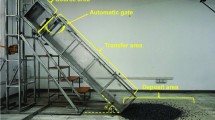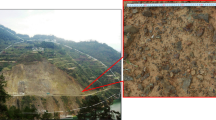Abstract
In silt low subgrade, capillary effect is an important factor inducing site erosion and collapse, and it is necessary to control the rise of capillary water. In this paper, the effectiveness of eight kinds of capillary barriers formed by geotechnical materials on the vertical migration of water in silt was studied by an indoor model test. Further field tests were carried out to verify the indoor test results. Finally, the vertical deformation of silt roadbed under different schemes was investigated through numerical simulation, and a reasonable scheme was put forward. The results show that among the eight schemes, the four combinations formed by gravel, coarse sand, lime soil layer with 40 cm thickness (curing for 45 days) and lime soil layer with composite geomembrane had the better barrier effect on capillary water, in which the dual capillary barrier using lime soil layer and composite geomembrane had the best effectiveness. The effectiveness of capillary barrier using composite geomembrane and 3% cement soil was the second, and the barrier effect of 5% lime soil cured for 7 days was the worst. The effectiveness of capillary barrier formed by lime soil increased obviously with the increase in age and thickness of lime soil. The numerical simulation results demonstrate that the improved capillary barrier effect reduced the vertical roadbed displacement. The vertical displacement at the center of the embankment was in the following order: lime soil > composite geomembrane > cement soil > coarse sand > gravel.















Similar content being viewed by others
References:
Bittelli M, Salvatorelli F, Pisa PR (2008) Correction of TDR-based soil water content measurements in conductive soils. Geoderma 143:133–142
Boulanger-Martel V, Bussière B,Té JC, Mbonimpa M (2016) Influence of freeze–thaw cycles on the performance of covers with capillary barrier effects made of crushed rock–bentonite mixtures to control oxygen migration. Can Geotech J:cgj-2015–0155
Cristi F, Fierro V, Suárez F, Muñoz JF, Hausner MB (2016) A TDR-waveform approach to estimate soil water content in electrically conductive soils. Comput Electron Agr 121:160–168
Fu Y, Horton R, Heitman J (2021) Estimation of soil water retention curves from soil bulk electrical conductivity and water content measurements. Soil and Tillage Research 209:104948
GB, T 17642 (2008) Geosynthetics-Geocompposites Made of Geononwoven and Geomembrance National Standards of the People's Republic of China
GB 5007–2011 (2011) Code for design of building foundation National Standards of the People's Republic of China
Guo J, Han J, Zhang X, Li Z (2019) Evaluation of moisture reduction in aggregate base by wicking geotextile using soil column tests. Geotext Geomembranes 47:306–314
He HL, Aogu K, Li M, Xu JH et al (2021) A review of time domain reflectometry (TDR) applications in porous media. Adv Agron 168:83–155
Hong Y, Rahardjo H, Leong EC, Fredlund DG (2004) A study of infiltration on three sand capillary barriers. Can Geotech J 41:629–643
Harnas FR, Rahardjo H, Leong EC, Wang JY (2014) Experimental study on dual capillary barrier using recycled asphalt pavement materials. Can Geotech J 51:1165–1177
Henry KS, RD Holtz (2001) Geocomposite capillary barriers to reduce frost heave in soils. Can Geotech J 38: 678–694(17).
Huo WW, Zhang WC, Zhu ZD, Peng YY (2021a) Experimental and numerical simulation study on mechanical and engineering properties of silt roadbed under capillary water. B Eng Geol Environ 80(10):8211–8229
Huo WW, Zhu ZD, Peng YY, Pu SY, Wan Y, Zhang C (2021b) Experimental study on capillary water rise and influencing factors in silty soil. Arab J Geosci 14:2706
JTJ 034–2000 (2000) Technical Specifications for Construction of Highway Roadbases. People's Republic of China Industry Standard, Ministry of Transport of the People's Republic of China, China.
JTJ E40–2007 (2007) Test Methods of Soils for Highway Engineering. People's Republic of China Industry Standard, Ministry of Transport of the People's Republic of China, China.
Krisdani H, H Rahardjo, EC Leong (2006) Experimental Study of 1-D Capillary Barrier Model Using Geosynthetic Material as the Coarse-Grained Layer. Unsaturated Soils, 1683–1694.
Kameyama K, Miyamoto T, Shiono T (2014) Influence of biochar incorporation on TDR-based soil water content measurements. Eur J Soil Sci 65:105–112
Lima MJ, Azevedo MM, Zornberg JG, Palmeira EM (2018) Capillary barriers incorporating non-woven geotextiles. Environ Geotech 5:168–175
Liu H, Sun S, Wang L, Zhang Y, Han L (2020) Microscopic Mechanism of the Macroscopic Mechanical Properties of Cement Modified Subgrade Silty Soil Subjected to Freeze-Thaw Cycles. Appl Sci 10:2182
McCartney JS, Zornberg JG (2010) Effects of infiltration and evaporation on geosynthetic capillary barrier performance. Can Geotech J 47:1201–1213
Morris CE, Stormont JC (1997) Capillary Barriers and Subtitle D Covers: Estimating Equivalency. J Environ Eng 123:3–10
Morris CE, Stormont JC (1999) Parametric Study of Unsaturated Drainage Layers in a Capillary Barrier. J Geotech Geoenviron 125:1057–1065
Ma Q, Liu S (2020) Effect on Silt Capillary Water Absorption upon Addition of Sodium Methyl Silicate (SMS) and Microscopic Mechanism Analysis. Coatings 10:724
Mancarella D, Simeone V (2012) Capillary barrier effects in unsaturated layered soils, with special reference to the pyroclastic veneer of the Pizzo d’Alvano, Campania, Italy. Bull Eng Geol Env 71:791–801
Miller DE, Gardner WH (1962) Water Infiltration into Stratified Soil. Soil Sci Soc Am J 26:115
Palmeira EM, Gardoni MG (2002) Drainage and filtration properties of non-woven geotextiles under confinement using different experimental techniques. Geotext Geomembranes 20(2):97–115
Park KD, Fleming IR (2006) Evaluation of a geosynthetic capillary barrier. Geotext Geomembranes 24:64–71
SL237–1999 (1999) Specification of soil test Ministry of Water Resources of the People’s Republic of China China
Stormont JC, Anderson CE (1999) Capillary Barrier Effect from Underlying Coarser Soil Layer. Journal of Geotechnical & Geoenvironmental Engineering 125:641–648
Topp GC, Davis JL, Annan AP (1980) Electromagnetic determination of soil water content: Measurements in coaxial transmission lines. water resour res 16:574–582
Topp GC, Davis JL (1985) Measurement of Soil Water Content using Time-domain Reflectrometry (TDR): A Field Evaluation. Journal Soil Science Society of America 49:19–24
Wen XP, Wen XZ, Zhang J, Xu TJ, Xu JJ (2015) Research on Effect of Capillary Water Rise and Layer Separation of Coarse Grained Salty Soil in Xinjiang Region. Journal of Highway and Transportation Research and Development 32: 56–60+67.
Wu SY, Yu JH (2013) Mechanical and engineering characteristics of capillary water of silty soils. Rock and Soil Mechanics 34: 80–84+91.
Zhan T, Li G, Jiao W, Tao W, Yun MC (2016) Field Measurements of Water Storage Capacity in a Loess/Gravel Capillary Barrier Cover Using Rainfall Simulation Tests. Can Geotech J 54:1–58
Zornberg JG, Mccartney JS, Bouazza A (2010) Geosynthetic capillary barriers: current state of knowledge. Geosynth Int 17:273–300
Zhang H, Wang X, Zhao X, Liu P (2020) In-situ experiment investigations of hydrothermal process of highway in deep seasonal frozen soil regions of Inner Mongolia, China. J Cent South Univ 27:2082–2093
Zhang LM, Y Ke (2017) Combinations of soil materials for granular capillary barriers for minimising rainfall infiltration and gas emission. Can Geotech J: cgj-2016–0334.
Acknowledgements
The authors would like to thank Bulletin of Engineering Geology and the Environment reviewers and editors for their instructive suggestions, which greatly improved this manuscript.
Author information
Authors and Affiliations
Corresponding author
Rights and permissions
About this article
Cite this article
Huo, W., Zhu, Z., Hao, J. et al. Experimental study and numerical simulation on effectiveness of different capillary barriers in silt low subgrade. Bull Eng Geol Environ 81, 246 (2022). https://doi.org/10.1007/s10064-022-02742-8
Received:
Accepted:
Published:
DOI: https://doi.org/10.1007/s10064-022-02742-8




